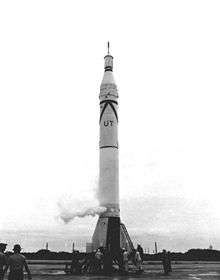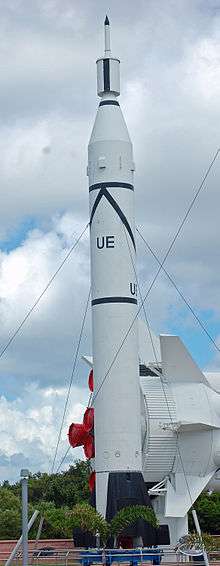Juno I
|
Juno I satellite launch vehicle carrying Explorer 2. (USAF) | |
| Function | Orbital launch vehicle |
|---|---|
| Manufacturer | Chrysler for the ABMA |
| Country of origin | United States |
| Size | |
| Height | 21.2 m (70 ft) |
| Diameter | 1.78 m (5 ft 10 in) |
| Mass | 29,060 kg (64,070 lb) |
| Stages | 4 |
| Capacity | |
| Payload to LEO | 11 kg (24 lb) |
| Launch history | |
| Status | Retired |
| Launch sites | LC-5 and 26A, Cape Canaveral Missile Annex, Florida |
| Total launches | 6 |
| Successes | 3 |
| Failures | 3 |
| First flight |
January 31, 1958 (First orbit: Explorer 1 January 31, 1958) |
| Last flight | October 23, 1959 |
| First stage - Redstone (stretched) | |
| Engines | 1x Rocketdyne A-7 |
| Thrust | 42,439 kgf (416.18 kN; 93,560 lbf) |
| Specific impulse | 235 sec |
| Burn time | 155 seconds |
| Fuel | Hydyne/LOX |
| Second stage - MGM-29 Sergeant cluster | |
| Engines | 11 Solid |
| Thrust | 7,480 kgf (73.4 kN; 16,500 lbf) |
| Specific impulse | 214 sec |
| Burn time | 6 seconds |
| Fuel | Solid - polysulfide-aluminum and ammonium perchlorate |
| Third stage - MGM-29 Sergeant cluster | |
| Engines | 3 Solid |
| Thrust | 2,040 kgf (20.0 kN; 4,500 lbf) |
| Specific impulse | 214 sec |
| Burn time | 6 seconds |
| Fuel | Solid - polysulfide-aluminum and ammonium perchlorate |
| Fourth stage - MGM-29 Sergeant | |
| Engines | 1 Solid |
| Thrust | 680 kgf (6.7 kN; 1,500 lbf) |
| Specific impulse | 214 sec |
| Burn time | 6 seconds |
| Fuel | Solid - polysulfide-aluminum and ammonium perchlorate |
The Juno I was a four-stage American booster rocket which launched America's first satellite, Explorer 1, in 1958. A member of the Redstone rocket family, it was derived from the Jupiter-C sounding rocket. It is commonly confused with the Juno II launch vehicle, which was derived from the PGM-19 Jupiter medium-range ballistic missile.
Development
The Juno I consisted of a Jupiter-C rocket, with a fourth stage mounted on top of the "tub" of the third stage, which was fired after third stage burnout to boost the payload and fourth stage to an orbital velocity of 8 kilometres per second (29,000 km/h; 18,000 mph). The tub along with the fourth stage were set spinning while the rocket was on the launch pad to provide gyroscopic force in place of a guidance system that would have required vanes, gimbals, or vernier motors. This multi-stage system, designed by Wernher von Braun in 1956 for his proposed Project Orbiter, obviated the need for a guidance system in the upper stages, proving to be the simplest and most immediate method for putting a payload into orbit; but as it had no upper-stage guidance, it could not inject the payload into a precise orbit. Both the four-stage Juno I and three-stage Jupiter-C launch vehicles were the same height (21.2 meters), with the added fourth-stage booster of the Juno I being enclosed inside the nose cone of the third stage.
The rocket family is named for the Roman goddess and queen of the gods Juno for its position as the satellite-launching version of the Jupiter-C. The name was proposed by JPL Director Dr. William Pickering in November 1957. The September 1956 test launch of a Jupiter-C for the Army Ballistic Missile Agency could have been the world's first satellite launch. Had the fourth stage been loaded and fueled, the nose cone would have overshot the target and entered orbit. Such a launch did not occur until early 1958 when a Juno 1 successfully launched the first United States satellite, Explorer 1, as part of Project Vanguard, after the Soviet Union's Sputnik 1 in October 1957.[1]
History
Although Juno I's launch of the Explorer 1 satellite was a huge success for the U.S. space program, only two of its remaining five flights were successful; launching Explorer 3 and 4. The American public was happy and relieved that America had finally managed to launch a satellite after the launch failures in the Vanguard and Viking series. With the relative success of the Juno I program, von Braun developed the Juno II, using a PGM-19 Jupiter first stage, rather than a Redstone.
The six launches of Juno I were:
- January 31, 1958: orbited Explorer 1 weighing 30.66 lb (13.91 kg) with 18.35 lb (8.32 kg) of payload, perigee 224 mi (360 km), apogee 1,575 mi (2,535 km). Explorer 1 ceased transmission of data on May 23, 1958 when its batteries died, but remained in orbit for more than 12 years. It made a fiery reentry over the Pacific Ocean on March 31, 1970.
- March 5, 1958: attempted orbit of Explorer 2, weighing 31.36 lb (14.22 kg) with 18.83 lb (8.54 kg) of payload, failed because fourth stage did not ignite.
- March 26, 1958: orbited Explorer 3, weighing 31.0 lb (14.1 kg) with 18.53 lb (8.41 kg) of payload, perigee 119 mi (192 km), apogee 1,740 mi (2,800 km). Down June 28, 1958.
- July 26, 1958: orbited Explorer 4, weighing 37.16 lb (16.86 kg) with 25.76 lb (11.68 kg) of payload, perigee 163 mi (262 km), apogee 1,373 mi (2,210 km). Down October 23, 1959.
- August 24, 1958: attempted orbit of Explorer 5, 37.16 lb (16.86 kg) with 25.76 lb (11.68 kg) of payload. It failed after booster collided with second stage after separation, causing upper stage firing angle to be off.
- October 23, 1958: attempted orbit of 12 ft (3.7 m) inflatable Beacon satellite (of Project Echo) 31.5 lb (14.3 kg) with 18.3 lb (8.3 kg) of payload. It failed when second stage separated prematurely from booster.
Gallery


References
- Source: Data Sheet, Department of Astronautics, National Air and Space Museum, Smithsonian Institution.
- ↑ Bello, Francis (1959). "The Early Space Age". Fortune. Retrieved June 5, 2012.
